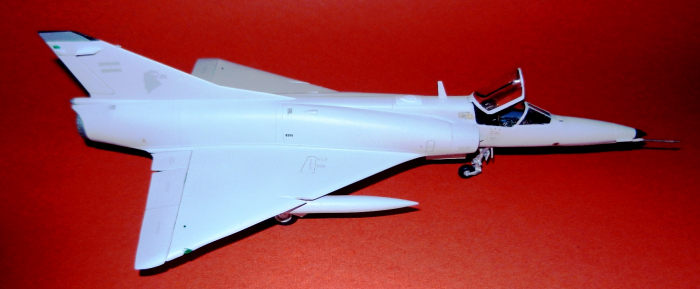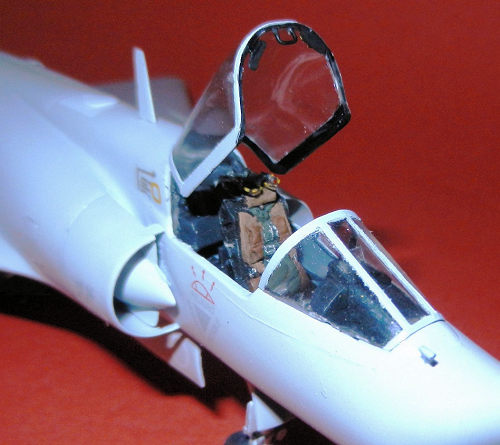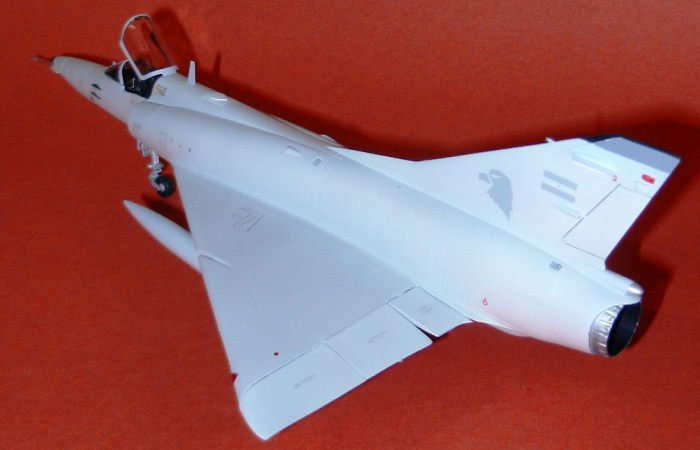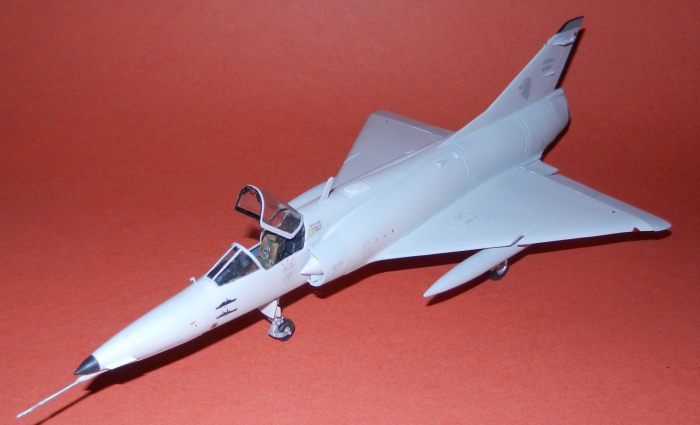
| KIT #: | 80411 |
| PRICE: | $30.00 or so |
| DECALS: | Four options |
| REVIEWER: | Pablo Calcaterra |
| NOTES: | Conversion. Aerocalcas decals. Resin nose |

| HISTORY |
Dagger C-412 started her life as Nesher S-49 and was delivered to the Argentine Air Force on November 16 1978 with 454 flying hours.
When the Argentine Air Force started to get ready for the potential war C-412 was flown to Patagonia and first was part of the 1st Escuadron Aeromovil (Avutardas Salvajes) and then was transferred to the 2nd Escuadron Aeromovil (La Marinette)
Early on May 1st, BAM (Military Air Base) Puerto Argentino/Port Stanley Airport was hit by bombs dropped by a RAF Vulcan and several low flying Harriers. The runway was hit by a bomb but continued operational for the rest of the war while infrastructure and parked planes received varying degrees of damage.
The FAA answered with several air patrols to try to intercept the SHARs with the objective of gaining air superiority. At 9:40, the Commander of the Task Force asked for the surrender of the Argentine garrison. When this request was emphatically rejected the detection of movement of helicopters and small ships around Puerto Argentino/Stanley made believe the defenders that a landing operation was being carried out. Thus the FAA sent strike combos to counteract the RN.
At 14:25 three RN warships started shelling the island. These were HMS Arrow, HMS Alacrity and HMS Glamorgan. As a consequence several missions were sent to attack them covered by Mirage IIIEA/Dagger CAPS.
Among all the planes that took part in this air strike, FORTIN were the most successful as they were the only ones that managed to reach and attack the RN on this day. C-412 took part in this attack. They were escorted by TORNO. For a detailed description of these two missions see this link.
On May 9 two British ships were detected close the
islands by the Argentine radar in Puerto Argentino/Port Stanley. Several
missions were launched to attack them. One of those waves included two squadrons
(PUMA and JAGUAR). The former was following OF1175 and was led by Mj Sapolsky
(who was in charge of the Daggers in San Julian) in C-401, 1st Lt Senn in C-407,
Capt. Diaz in C-432 and 1st Lt Callejo in C-412). They took off at 13:40 but
after reaching Gran Malvina (West Falkand) in bad weather (8/8 clouds and rain)
they were unable to make contact with the radar in Stanley/Puerto Argentino and
decided to abort the mission, landing back at 15:10. It must be remembered that
a section of A-4Cs
 (Casco and
Farias) tried to attack the same targets and crashed against an island in low
clouds (see this
link for more details)
(Casco and
Farias) tried to attack the same targets and crashed against an island in low
clouds (see this
link for more details)
When the British forces landed at San Carlos on May 21st the Argentines threw everything at them. Taking off at 8 am one of the first attack missions (OF 1184) was led by then Capitan Diaz in C-412. His wingmen were Aguirre Faget in C-415 and Cpt Dellepiane in C-434. Their call sign was ZORRO and they were armed with a single British MK17 of 1,000 lb (Diaz claims they were armed with 2 x 250 kg bombs). Diaz recounted that being in the officer in charge of Operations of his squadron he was the one who assigned the pilots to the missions. While working on this they received the urgent order to attack the British forces landing in the islands. Though originally the weather was bad in the continent it started to become better and opened up as they approached the islands. When close to Gran Malvina (West Falkland) they descended and started a ultra-low height pattern towards San Carlos. They contacted the previous M5 Squadron (LEON) who warned them about the important number of ships on the Strait/Sound. When the Daggers arrived over the water Diaz found a scene that was worse than what he had imagined. He could see the defensive positions taken by the RN ships. They were placed in a half circle. The Daggers approached the targets flying at 530 knots (980 km/hr) and at no more than 10 ft (3 meters) over the water. They were in a single line, one behind the other. Diaz decided to attack a Type 22 that was closer to them. It was HMS Broadsword. When 1,000 meters away he started to shoot with his 30 mm cannons. Focused on their gunsights they were unaware of the amount of fire being sent their way. Due to a mechanical problem none of the Daggers were able to drop their bombs (they were duly inspected after they returned and defects were found in 2 out of the 3 planes). They jumped over their target and felt their drop tanks being hit by the flying debris of the frigate. Aguirre Faget felt something hitting his plane. Only now they realized the massive amount of guns, tracers and missiles being fired by the British. They were attacked by the AAA from a ship located to their right (probably Brilliant). After escaping they returned to their base where they found that the planes had being hit in different degrees: drop tanks, in the case of C-434 a piece of shrapnel perforated the left air intake and 3 inch wide had entered the plane thru the nose and was stopped by the pedals without hitting the pilot, C-412 in the lower VHF antenna that was damaged by a 12.7 mm round. The antenna was easily replaced and was hung in the hangar as a good luck charm. As for Broadsword 14 men were wounded and two Lynx helicopters damaged.
As a continuation of the attacks LAUCHAs and RATONes were to attack the enemy ships in San Carlos Sound in the early hours of the afternoon. Because of a delay on starting the engine of RATON 3 the leader of the LAUCHA (Lt Roman in C-421) asked Capt Donadille (leader of the RATON) to switch the order not to further delay the mission. Thus OF1199 took first and with Major Puga in C-412 and 1st Lt Callejo in C-415 Roman proceeded to the landing zone. In this case and following a very similar approach as Diaz during the morning they attacked HMS Brilliant with bombs (Roman’s did not detach) and 30 mm guns while Callejo attacked Broadsword again. Now C-412 and C-415 had impacts on their armoured windshields. As a consequence they had to be rotated out of action to be repaired. Brilliant received several 30 mm impacts on her structure as shown in multiple pictures. Four of her crew were injured, and the Sea Wolf, Exocet and sonar were put out of action. For what happened to the RATON you can read https://modelingmadness.com/review/mod/fr/calm3.htm.
C-412 was back in action on May 29th as part of two sections of 3 planes that were to bomb troops and helicopters. The first section was called PUMA and LEON (OF1270) was flown by 1st Lt Roman (C-432), Lt Aguirre Faget (C-412). When flying low and close to Borbon/Pebble Island Dellepiane saw a British PAC homing on them to shoot them down. He ordered his men to abort the mission and return home. They managed to evade them. Following them just a few minutes later Roman could hear Dellepiane’s commands and he asked what was going on. Demierre (PUMA 3) told them to get back because it was a trap. Thus Roman and Faget also turned back having aborted their mission.
 The last
mission of this plane during the war was during the Bluff Cove Disaster (Bahia
Agradable) or the Darkest Day of the Task Force. As the low flying attack planes
(Skyhawks and Daggers) were attacking RFA Sir Lancelot (heavily damaged and had
to be transported back to the UK abroad a heavy lift ship), RFA Sir Galahad
(destroyed and sunk after the war), HMS Plymouth (heavily damaged) and Foxtrot 4
(sunk) two sections of 3 Daggers were feinting attacks by entering the theater
at high attitude. These were CARTA (OF 1293 with Vice Commodore Villar in C-411,
Lt Valente in first war mission in C-412 and 1st Lt Callejo in C-432) and SOBRE.
They pretended to be an attacking mission flying a direct route to Bluff Cove.
They reached Jason (Sebaldes) Islands and attracted some PACs that chased them.
Having lured some Harriers away from the main striking force they returned to
their base with their mission successfully accomplished.
The last
mission of this plane during the war was during the Bluff Cove Disaster (Bahia
Agradable) or the Darkest Day of the Task Force. As the low flying attack planes
(Skyhawks and Daggers) were attacking RFA Sir Lancelot (heavily damaged and had
to be transported back to the UK abroad a heavy lift ship), RFA Sir Galahad
(destroyed and sunk after the war), HMS Plymouth (heavily damaged) and Foxtrot 4
(sunk) two sections of 3 Daggers were feinting attacks by entering the theater
at high attitude. These were CARTA (OF 1293 with Vice Commodore Villar in C-411,
Lt Valente in first war mission in C-412 and 1st Lt Callejo in C-432) and SOBRE.
They pretended to be an attacking mission flying a direct route to Bluff Cove.
They reached Jason (Sebaldes) Islands and attracted some PACs that chased them.
Having lured some Harriers away from the main striking force they returned to
their base with their mission successfully accomplished.
Program Finger:
Before the war the Argentine Air Force was already embarked in a program to modernize the Daggers into a Kfir with a Snecma engine. This program was called SINT. The contract was going to include a HUD with a PDU (Pilot Display Unit), a NCU (Navigation Control Unit). In 1981 the Installations in Area Material Rio Cuarto were modified to carry out the project. C-427 was chosen to be the prototype. Parts in the contract were supplied by IAI (new nose and integration of the system), Marconi for the HUD, EU, ADC and ADR, ELTA Systems for the radar EL/M1001B, SFIM for the ISU and radio altimeters and Canadian Marconi for the Doppler. Argentine technicians flew to Canada, France, Israel and England to get trained in the different systems. Flights and development took place in Israel and once the first 2 phases had been completed C-427 was shipped to Argentina in an Argentine C-130. With the foreign technicians working in Argentina and 3 planes in different degrees of conversion the war broke out and the Canadian and British teams left immediately for their countries leaving the kits and instructions behind. The Argentine team had already acquired the know how to put together the kits, convert the planes. Due to the fact that after the war the British and Canadian refused to deliver the remainder of the parts that had been part of the program the Argentines managed to obtain some of the missing components of British origin using some resourceful initiatives and then Commodore Candeago decided to change the name of the program from SINT to Finger (you can imagine why…).
In 1983 progress to convert some planes with the available components resumed. As there was an interference with the Doppler radar located under the nose the VHF antenna was moved to the tail. Now the planes were called Finger II.
 Thompsom
CFS and Israeli Astronautics were the new suppliers of components to convert the
entire fleet of Daggers. With these new suppliers and modifications the program
was called Finger IIIA. The integration of the systems turned out to be very
successful and navigation and fire systems achieved a high degree of
proficiency.
Thompsom
CFS and Israeli Astronautics were the new suppliers of components to convert the
entire fleet of Daggers. With these new suppliers and modifications the program
was called Finger IIIA. The integration of the systems turned out to be very
successful and navigation and fire systems achieved a high degree of
proficiency.
Finger IIIB had the EU from Thompson instead of the original Marconi. Finger IV was supposed to have a RWR. The first plane to incorporate this very much needed system was C-412 but when the Mirage 5P were modernized these received the RWR originally destined for the Finger fleet and became the Maras between 1988 and 1991. For a while C-412 kept the RWR receptors on the tail but then only the supports remained.
With the Finger program the Argentine Air Force finally had a very modern fighter bomber that was capable of navigating with high precision, bomb accurately with a 10 km range in the air to ground mode and 5 km in the air to air mode. None of these features had been available during 1982 and would have made a significant difference.
The last modification to the Fingers was the incorporation of GPS and that happened during the early 2000s.
Like all the Delta fighters in service in the Argentine Air Force (Mirage IIIEA, Mara) Fingers were SOC in December 2015 leaving the Air Force without a supersonic combat aircraft.
| THE KIT |
If I have to choose between the Heller and the Esci/Italeri kit I prefer the French one. It is more detailed with more panel, grids and other good surface detail (though still has raised panel lines), offers a single and two seat versions. On the down side it only has supersonic wing tanks and no armament at all. Decals are also a bit of a disappointment as well, being mostly out of register and for French subjects. Trees are not bagged in the box so scratches on the clear parts are to be expected.
Finally…the engine, tail cone and nose are suitable for the B/C versions but not for an E or 5 and this is part of the project I had to tackle.
| CONSTRUCTION |
I started with the fuselage. As stated the exhaust and the tail cone are for the B/C version. I had made some templates in latex using the Esci kit and then with resin (tinted in yellow) I made these parts plus the extra fuel tank located under the fuselage close to the tail and the 4 small extensions for the modifications to be made to the fuselage around the cockpit.
I assembled the cockpit (using a picture of the instrument panel of a Finger as the source for a self-made decal) and the side consoles were scans of the Esci decals that I also printed in decal paper. On the fuselage around the cockpit I erased the supports and guides for the air intakes as these have to be moved backwards. I had to change the position of the landing gear opening forward. The rear gap was covered with another resin plug that I made. The round clear piece under the nose (for a camera?) was replaced with pieces of plastic and puttied. The ejection seat is a copy I made in resin of an aftermarket set (have not kept a record of the brand)
I cut out the B/C tail cone and glued the fuselage halves. With these ready I very carefully attached my inserts to the front of the main fuselage and then attacked the front side of the fuselage (cockpit area) minus the nose (that I had cut out beforehand). The inserts I made were long enough to ensure that the intakes start at the end of the canopy per the MIII or M5 versions. With plasticard I created a new triangle shaped support to be placed under the air intakes. Not as nice as the original ones (which are far superior to Esci’s) but needed and effective. The new tail cone and exhaust were added and the fuel tank under the tail was glued with super glue (gel). I used putty to merge all these new parts all together.
To add some fun and movement to the plane I cut out
the elevons and glued the halves together. The bottom side of the wings was
glued centered. To make a more sturdy union of the top of wings-fuselage, I cut
some pieces of plastic sprue and placed them on the inside of the bottom wings
below the top wing halv es
close to the fuselage. This prevented this area from being pushed doing during
handling the kit. Once the front part of the elevons was rounded a bit these
were glued onto the wings. The ones closer to the fuselage are always more
neutral while the other four sections can be glued in a lower position. The back
part of the actuators for the elevons had to be cut in an angle to follow the
angle of these pieces.
es
close to the fuselage. This prevented this area from being pushed doing during
handling the kit. Once the front part of the elevons was rounded a bit these
were glued onto the wings. The ones closer to the fuselage are always more
neutral while the other four sections can be glued in a lower position. The back
part of the actuators for the elevons had to be cut in an angle to follow the
angle of these pieces.
The IFF system on the tail is placed on top of some oval supports. I cut these shapes from plastic and used Putty to improve the union sanding the edges improving the curvature. The Finger/Kfir resin nose from an Argentine company (again apologies but have not kept the brand or records) was added and the union was improved using some putty and sandpaper. The supersonic tanks were glued together. The back of the air intakes were painted in black. Landing gear and wheels were assembled and set aside.
The VHF and IFF antennas were cut from strips of Evergreen. I made them slightly longer to bury them in blue tac to paint them. Once dry the part that was buried in blue tac was cut out delivering the proper length for these parts. The RWR base on the tail was made with pieces of Evergreen.
| COLORS AND MARKINGS |
Vallejo Light Grey was used as primer. Once it was dry I sprayed the wheel bays and landing gear with Vallejo Aluminum. Maskol and foam were used to protect these parts before spraying the entire plane with ModelMaster 4765 (FS36495).
 The tip of
the nose, top of tail and the fake canopy under the nose were painted in flat
black. The 30 mm guns openings were painted with black as the front of several
air intakes around the plane. Some panels and moveable surfaces of the plane
were highlighted using a 4B pencil.
The tip of
the nose, top of tail and the fake canopy under the nose were painted in flat
black. The 30 mm guns openings were painted with black as the front of several
air intakes around the plane. Some panels and moveable surfaces of the plane
were highlighted using a 4B pencil.
The landing gear was added (minus wheels) and then Future gave a gloss surface for the decals: AeroCalcas for the eagle for the Grupo 6 on the tail and all the stencils. I found a picture of the kill marks added to C-412 in the early 2000s that represent HMS Arrow and HMS Brilliant and created my own decals. From the spares I took a “12” that goes inside the landing gear door. A rectangular piece of white decal represents the panel that gives access to the fuel tank behind the canopy.
| FINAL BITS |
The air intakes, drop tanks and wheels were added. Finally, a coat of semi gloss clear varnish from AeroMaster sealed the decals. All the position lights were painted first with light grey, followed by aluminum and then ModelMaster clear green or red.
 Hydraulic
actuators and landing lights were painted Silver. These last ones are missing in
the kit so I made them with pieces of clear plastic tree, shaped them with
sanding paper and glued them place. They received drops of Future to represent
the front glass.
Hydraulic
actuators and landing lights were painted Silver. These last ones are missing in
the kit so I made them with pieces of clear plastic tree, shaped them with
sanding paper and glued them place. They received drops of Future to represent
the front glass.
The sequence to add all other parts started from the center moving outwards:, main landing gear doors, wing drop tanks. Then I moved to the top portion of the plane. Gunsight, compass and clock (scratchbuilt) on the windshield, windshield itself, ejection seat (a large chunk of bottom was sanded away to make it fit) with scratchbuilt ejection handles between legs and on top of headrest, stick, VHF and IFF antennas, the little antenna in front of the tail and the two little wings on the side of the nose. A thin piece of Evergreen shaped as a tear drop was bent a bit and glued on top of the access panel to the fuel tank behind the canopy.
The model was finished when I scratch built the prominent Pitot tube on the nose and the last detail was adding the canopy with photoetched mirrors and the central handle.
| CONCLUSIONS |
I know that there are Kfirs out there that can much easily be converted into a Finger but these are more expensive than the Heller kit. Besides I find it satisfying to overcome the difficulties and deliver what I want. This Finger that flew in the first and last Dagger missions during the 1982 war stands out among all the other Argentine planes in my collection with her light grey colour and the eagle of the Grupo 6 on her tail.
| REFERENCES |
Dagger and Finger en Argentina (1978-2004) by Claria, Mosquera, Posadas, Cettolo, Gebel, Marino
Official History of the Air Force (Book VI – volume I and II)
Ellos tambien combatieron (They also fought) by Posadas
Sea Harrier FRS1 vs Mirage III/Dagger by Dildy/Calcaterra
29 June 2021
Copyright ModelingMadness.com. All rights reserved. No reproduction in part or in whole without express permission.
If you would like your product reviewed fairly and fairly quickly, please contact the editor or see other details in the Note to Contributors.